Chill out at Ventura California
Chill out at Ventura California Ventura Beach has gone above and beyond for my expectations….
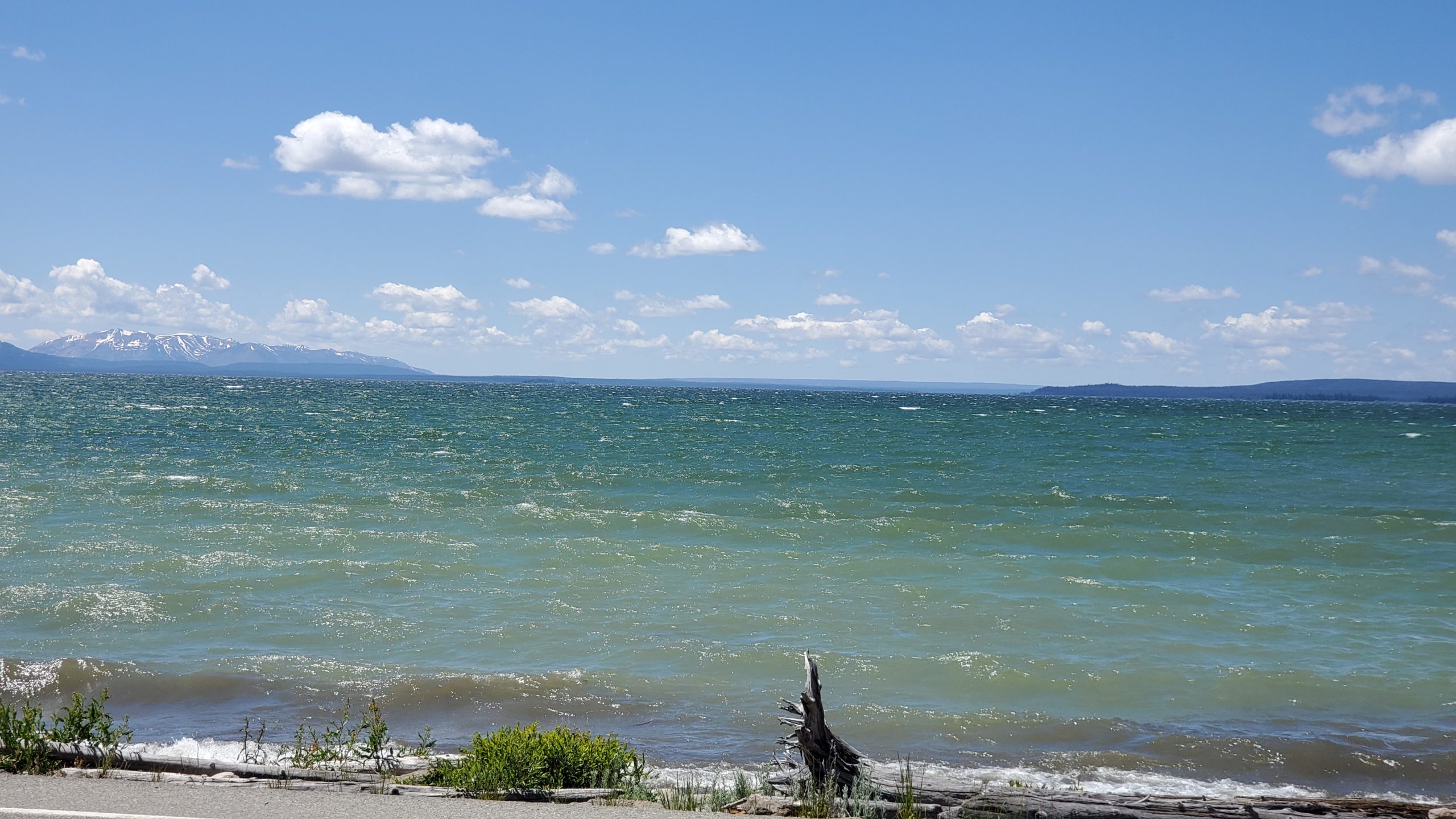
Driving through the Yellowstone National Park East Entrance from Cody Wyoming is a beautiful drive past a beautiful lake and dam. You will also drive through a tunnel that gave me a heart attack. This was due to me never measuring my RV before leaving the house. Past some awe-inspiring ranches that I could only dream of owning. Then after you travel past all that you enter into the East Gate of the Nation’s first National Park established in 1872 by President Grant. Yellowstone National Park!
Driving through the Yellowstone National Park East Entrance favorite drives in the park. This is because you get to drive through the Sylvan Pass! The Sylvan Pass is a paved road and the only way to enter Yellowstone National Park from the East. Its elevation is 8,524 ft. We drove this in our RV, we were heading from the East entrance, through the park, to the West Entrance. It is a challenging drive in a large RV.
Make sure that you are downshifting while going down the mountain pass. This will assist in making sure you do not overheat those brakes. There is no real good way to get off the road and to safety if you lose those brakes. Heading up the hills and around the curves, go slow and watch what you are doing. You should be fine as long as you are aware of your surroundings and watch what you are doing.
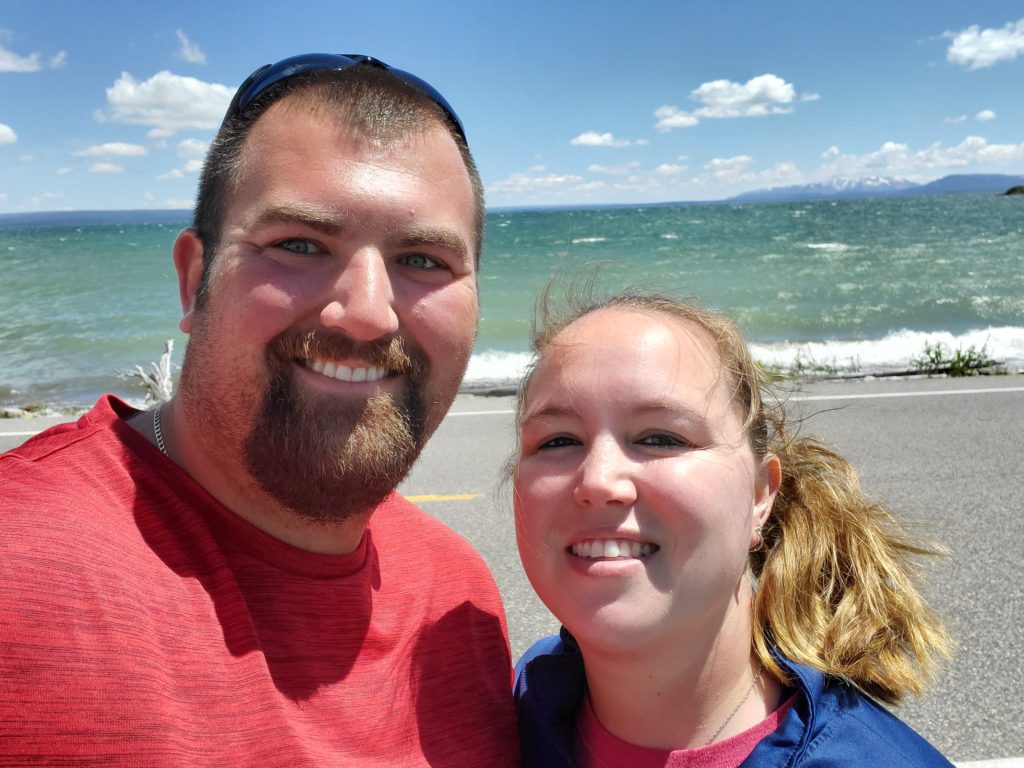
When you get through the mountain pass, do yourself a favor and shut off the AC, open the windows and enjoy that AMAZING mountain air that is cool and crisp. It was such a relief once we were able to get the air in our camper and cool it off (during much of the travel to get to Yellowstone the AC and our generator on our RV had stopped working and IT WAS HOT!!!!)
Once you get through the pass make sure you have a lunch ready and pull over next to Yellowstone Lake. The lake is the largest freshwater lake in America above 7,000 Ft. The Yellowstone Lake is 7,732 ft above sea level and covers 136 square miles. Yellowstone Lake has an average depth of 139 ft deep and is 394 ft deep at its deepest point.
Yellowstone Lake has the prettiest deep blue color, with the clean, crisp breeze running over the lake all you can hear and feel is the mountain air. It is the cleanest air I have experienced outside of Alaska.
When you get down to the lake, there is a great spot to pull over and get out of the car. Let the kids run down to the lake, dip their toes in and have a nice picnic. It is a perfect spot that does not have a lot of traffic. You can get a little spot all to yourself and enjoy the lake views with the mountains backdrop in the distance. The boys loved being able to run barefoot on the lake shore. We enjoyed watching them laugh and run around like mad men.
It is a great spot to fill your soul with joy and peace. As well as fill your bellies with some much-needed lunch.
Continuing on down the road toward the Grand Loop Road you will come to Lake Village. Lake Village is located on the Northwestern corner of Lake Yellowstone National Park and it houses a lot of amenities that you need to consider.
Lake Village has a fantastic shop you need to stop at and check out some unique gifts and hiking gear. We purchased some Yeti water bottles that you only can get in Yellowstone national Park, and we love them. We still use these water bottles every day. Lake Village also offer groceries, gas, a museum, and a visitor center.
This Campground offers RV camping as well as tent and has no hookups, no Wi-Fi and has a max length of 40’. Generators are allowed to run from 8am-8pm. I would not think there is much need for a generator as the temps in Yellowstone are near perfect, even a little chilly at time.
I would consider being respectful of those around you and maybe only run to make your coffee and maybe charge the batteries up. There are 16 restrooms located throughout the campsite as well as dishwashing stations. You can have a personal shower located on site as long as you collect the wastewater and dispose of it properly.
The Bridge Bay Marina offers boat rentals that is sure to be a memorable way to enjoy Lake Yellowstone, just make sure you take a jacket as it will get chilly out on the water, even in the middle of summer.
Wanting to do some hiking? There is a family friendly hike very close to the Bridge Bay Campground that is worth stopping in and checking out. It is called Natural Bridge, it is a 3 miles hike that is classified as an easy hike. This will take you to a large rock bridge that is 30 ft wide and stands 50 ft over Bridget Creek. The trailhead can be found just south of the marina along the main road. If you have some bikes with you, you can also ride your bike to Natural Bridge.
I do want to give a reminder that if you are doing any hiking in Yellowstone National Park I recommend always having a can of bear spray on you and know how to use it.
My favorite area is called Fishing Bridge. In my opinion Fishing Bridge is going to offer you some of the best RV camping inside the park. It is the only park inside Yellowstone National Park that offer electric, sewer, and water. Due to Grizzly Bears frequently visiting the campsite, there is no soft sided campers of any kind allowed in the campsite.
Fishing Bridge offers 310 sites that are RV only and has nearby laundry and showers for free. Fishing Bridge can accommodate combines unit length of 40’. When we visited Yellowstone National Park fishing bridge was undergoing a complete renovation and was closed.
When we go back to Yellowstone this is the campsite I want to stay at. The location is perfect located right on the Grand Loop Road and almost directly in the center of the park. Staying here would shave at least an hour of drive time every day.
If you are not in a RV you can always stay at the Lake Yellowstone Hotel and Cabins. Originally built in the 1920’s and completely remodeled in 2004 this Hotel offers a variety of different rooms and cabins at a variety of different prices. I am not going to dive deep into this because I prefer to stay in the RV. Just wanted to give the option if you are traveling without a RV.
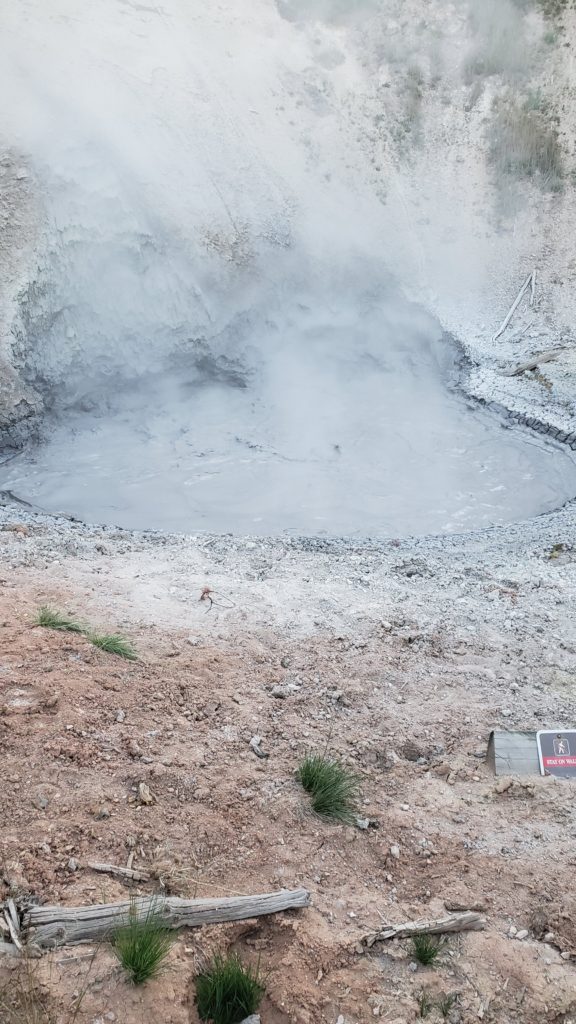
On the Eastern section of the Grand Loop Road right after the Yellowstone National Park East Entrance. There is a unique thermal feature that is worth stopping in and checking out. Like most places in Yellowstone, the first thing you will notice once getting out of your car is the strong odor of Sulphur. Most of these thermal events and thermal features have a strong Sulphur smell and it is really hard to get past when you first get here, but you will get used to it. It’s a small price to pay in order to experience all that Yellowstone National Park has to offer.
The Sulphur Caldron got its name from being one of the most acidic hot springs in Yellowstone National Park. Sulphur Caldron water seem to be turbulent from all the gases escaping and causing the cooler water on top to the bottom, being replaced by the hot waters raising, this circulation of water and the canals having no restricting allow this to be a hot spring and not have any eruptions. The waters of the Sulphur Caldron have a PH leve of 1-2 which would make these waters as acidic as a car battery or your stomach acid.
As you are visiting the Sulphur Caldron make sure you make your way over to the Mud Volcano Area. The mud volcano area was one of the first thermal features we stopped at while in Yellowstone National Park. It consists of mud pots that are warmed by steam and causes a thick mud pie bubbling with gases. From the looks of it, it looks like it would be an amazing place to take a dip and enjoy a mud spa day, but keep in mind these are full of acid that is constantly eroding the ground around it causing more mud to form.
This area is near the most active part of the Yellowstone Caldera floor that is moving up and down with the fluctuation of the magma below the surface. This makes earthquakes very common.
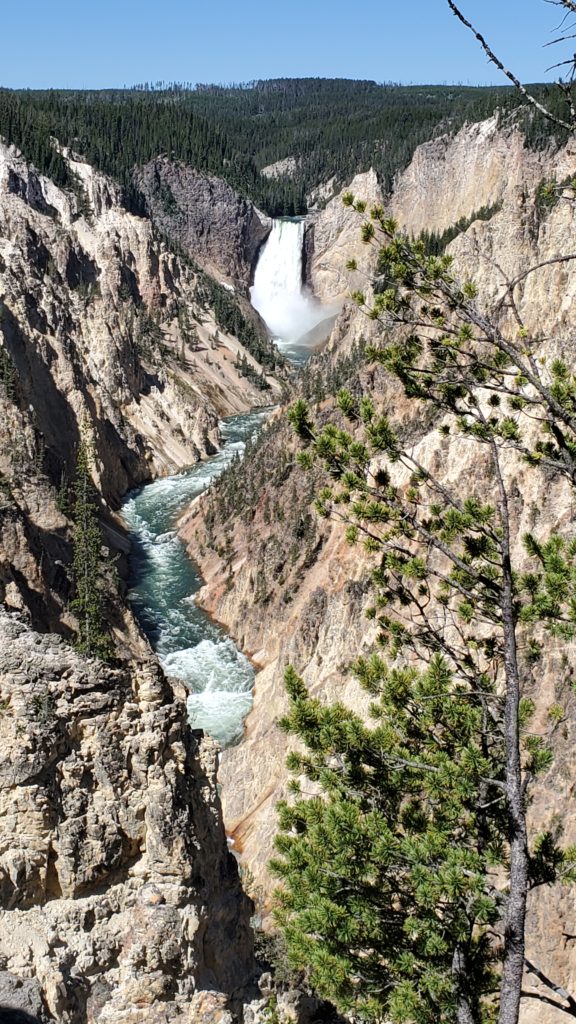
Wanting to check out some of the best waterfalls of Yellowstone National Park? You are going to need to jump on the Grand Loop Rd in the park. You will come across my favorite part of the entire Park, the Grand Canyon of Yellowstone. While experiencing the Grand Canyon of Yellowstone, a few must dos for the family is to experience both the Upper Falls and the Lower Falls.
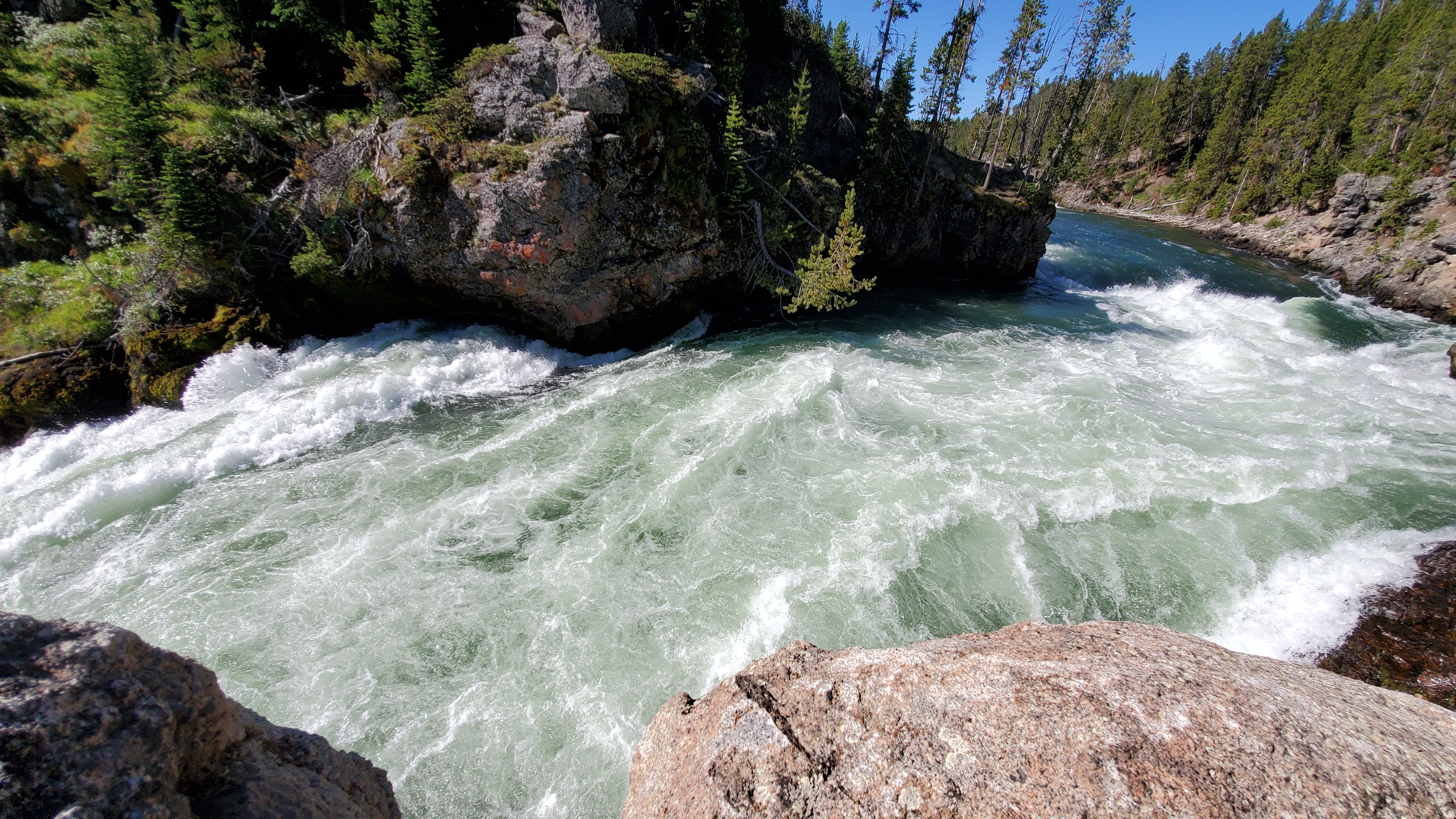
So, let’s dive right into the Upper Falls of the Yellowstone River. Here you can walk the .25 miles round trip to the Brink of the Upper Falls where you will have a 75 ft change in elevation. There are some other hikes that are not as family friendly but will get you right to the falls and are not as busy. It’s a great place to go and have a one of a kind experiences with the falls.
The upper falls is a 109 ft cascade at the top of the Grand Canyon of Yellowstone. I can still hear the water rushing in my soul. This entire area of Yellowstone gives you breathtaking views of the powerful river and the landscape is just stunning.
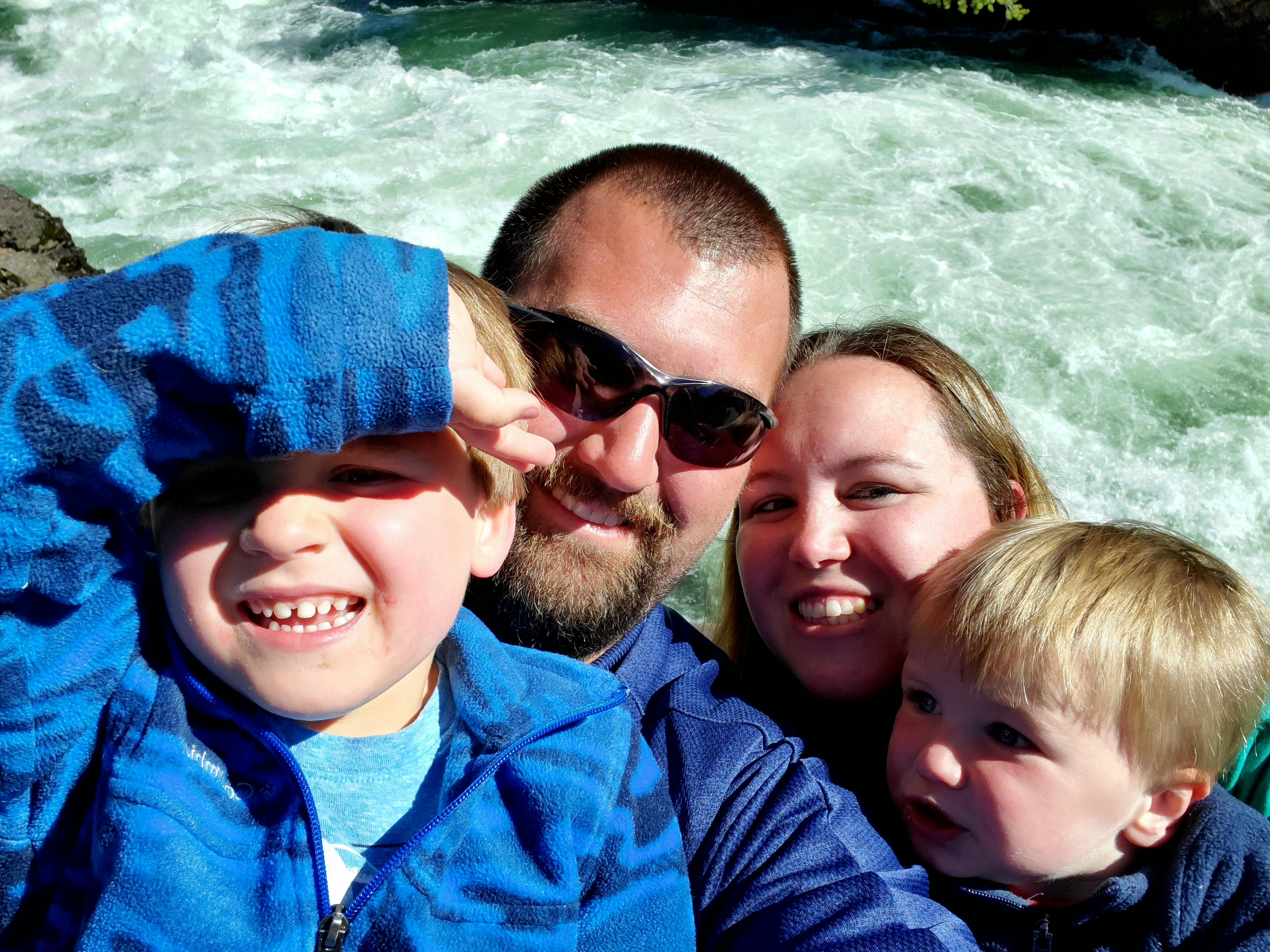
Brink of the Upper Falls hiking trail is .25 round trip and is an easy trail to hike. Definitely a good family friendly trail. This trail will take you right up to the brink of the falls. The sound of the water rushing over the edge will fill your soul with peace and tranquility.
I can still hear the rushing sounds of the powerful falls! These falls have an estimated 5,000 gallons of water/ second on dry seasons. Over 60,000 gallons of water/ second on peak season!
The lower falls are a quarter mile downstream from the Upper Falls. The lower falls are quite a bit larger than the upper falls. So much that they are actually twice the height of Niagara Falls and the tallest waterfall in the Rocky Mountains. The Lower Falls are 308 ft tall and have during peak season has 8,400 cu ft/s of mountain runoff water that rush over the edge.
The viewpoint to the Upper Falls offers some of the best pictures in Yellowstone National Park (except maybe the Grand Prismatic). There have been many famous pictures and paintings of the upper falls that come from the vantage point. With that popularity comes the crowds. It is busy here but worth wading through the tourist to get that perfect shot of the most amazing waterfall I have seen to date.
The boys loved being able to get so close to the waterfalls. My kids are definitely water babies. They never miss an opportunity to get wet, jump in a puddle, or go for a swim. This may have been their favorite part of the entire trip.
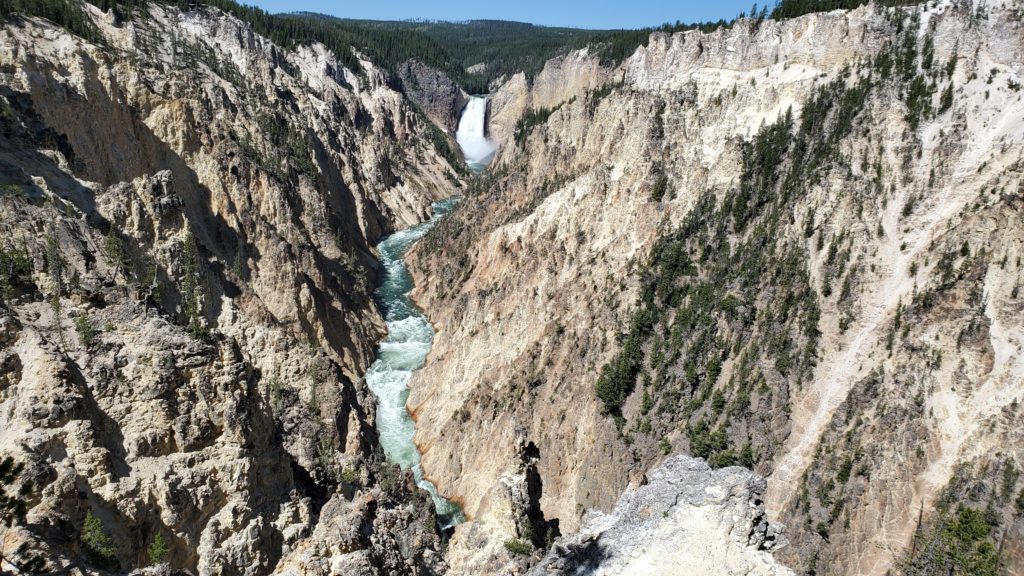
If you are feeling more adventurous, you can take the Uncle Tom trail at the lower falls. This trail takes you from the top of the Yellowstone Grand Canyon to the brink of the Lower Falls. If you decide to try to tackle this trail you will have to go down and back up 328 steps covering 500 vertical feet. There are places along the trail to stop and take a break but young children might not appreciate this trail very much.
If you want to enjoy the lower falls and not deal with all the steps, you can take the .2-mile trail to Artist point. This is an easy walk and it takes you to some amazing views of the Lower falls. This is the trial we decided was best suited for us and the kids. It was easy enough that we did not need to use the backpack carrier for Jameson. We were able to just let the boys walk it on their own. They did not have any problems.
There is plenty to do and see around the Yellowstone National Park East Entrance. Make sure you take your time. Plan ahead. Start early and enjoy yourself. There is a lot to take in. Don’t rush it.
Chill out at Ventura California Ventura Beach has gone above and beyond for my expectations….
Getting Poked at Joshua Tree National Park Palm Springs/Joshua Tree KOA Holiday Desert Hot Springs…
Slowly melting at Saguaro National Park Saguaro National Park was no disappointment! It is amazing…
White Sands National Park: Nature’s Playground WE FOUND SNOW IN NEW MEXICO!!!! Nah not really,…
Guadalupe Mountains National Park Our last stop in Texas during our 2024 Summer of Sunscreen…
Exploring Carlsbad Caverns: An Unforgettable Adventure Here we are in New Mexico. We are about…